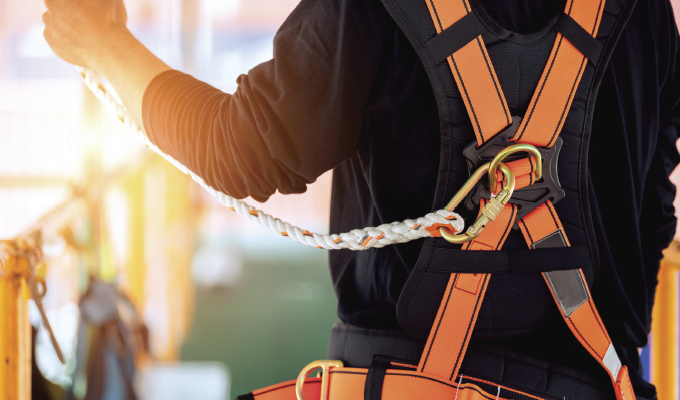In a recent analysis of Travelers’ workers’ compensation data over a 5-year period (2015-2019), we found that almost half—48%—of all construction workers’ compensation claims occurred within the first year of a worker’s employment. This was across both age and experience levels, meaning it wasn’t just those who were new to a construction career or to the workforce in general. In fact, according to our data, when looking at construction injuries with workers within their first year of employment, 35% of those claims came from employees who were 35 to 49 years old.
With regard to injuries across all construction workers, we found that the most frequent causes were slips, trips and falls (27%), overexertion (25%), being struck by an object (14%), cuts or punctures (7%), and motor vehicle accidents (6%). Slips, trips and falls, being struck by an object, and motor vehicle accidents were also among the most expensive causes of construction injuries.
The most frequent resulting injuries were strains and sprains (30%), fractures (20%), dislocations (10%), cuts or punctures (8%), and contusions (6%). The most severe resulting injuries were electric shock, multiple traumas, cardiovascular injuries, amputations, and head traumas. The most common body parts affected were the lower back, shoulders, and knees.
What safety initiatives might be implemented to help reduce first-year injuries?
With proper precautions, many of these injuries can be avoided. Safety initiatives can start before a worker’s first day, during the hiring process. Clear job descriptions that convey an organization’s safety culture and expectations around best practices can help attract qualified job candidates. Behavioral interviewing techniques can help ensure that candidates have the right experience and training for the positions. Asking safety-related questions can help determine if the prospective employees believe in safety values similar to those of the company. For instance, when trying to get an understanding of a candidate’s previous use of various machinery on jobsites, ask the candidate to run through their pre-start checklist.
Once hired, onboarding and training can begin on day one, even before an employee starts executing the tasks of their new role. This process includes orienting new employees to their jobs, their crew and assigned tasks, as well as to any tools or machinery, and reviewing the organization’s safety expectations and procedures. Continuing safety training programs and practices throughout an employee’s time at an organization is also critical.
And because employees are still at risk for injuries at work after the first year on the job, it’s important to encourage employees at all levels to get involved with safety initiatives, model the right behaviors to others and provide feedback, as more experienced employees are often aware of issues and can offer insights as to how to improve the work environment.
What can construction companies do to keep their safety programs and training from becoming stagnant or stale?
One thing that construction companies can do is to periodically examine workforce strategies to determine if they are enough to keep their employees skilled, safe, and resilient. This evaluation could include conducting a critical analysis of all jobs on a jobsite to determine if they’re designed to be as safe as possible, thus helping reduce the chance that employees make unsafe choices, or to conduct a workforce pressure test to uncover any potential issues.
Construction companies can also ask employees for their input. Have an honest, open conversation about what workers see, what they want to change and how they think tasks can be completed more safely. Incorporating that feedback can greatly improve existing safety and training programs.
Outside perspectives help, too. Contractors typically only see their jobsites and may only have a limited line of sight to the types of losses the industry is experiencing. But some of their external partners, such as the insurance carriers, could provide some valuable insights. At Travelers, our dedicated Risk Control and Claim professionals conduct benchmarking across the country and can share with customers what peers are doing differently and what trends in safety they are seeing.
What are some of the initiatives that are successful in keeping workers safe?
Construction companies that prioritize a culture of safety and regularly communicate these values and best practices are the ones that tend to be most successful at keeping workers safe and preventing loss. This starts with top management, who lead by example, plan for the work ahead and hold workers accountable to already established safety programs.
In terms of specific initiatives, one is an accident analysis program, which can aid in the identification of the root causes of injuries after accidents have occurred. Companies can develop corrective actions to help reduce the subsequent occurrence of similar accidents and injuries. Each analysis documents a description of an accident, where it occurred, what may have caused or contributed to the accident, and whether the employee involved was new to the position or company, along with recommendations to help avoid similar accidents. This analysis can be used to better understand employee injury risks and then to update your training programs and mitigation plans.
CLOSING THOUGHT
Lastly, put a post-injury management process in place. This can provide supervisors with best practices for responding immediately and nonjudgmentally when an injury takes place and thus help injured employees feel valued. Assigning transitional duties when medically possible is a part of this process, keeping those who are injured engaged and connected to the workforce as they recover. This is especially important in construction, given the amount of time workers can miss if they’re injured. Our data shows that construction workers on average missed 98 days, the most in any industry we analyzed.
About the Author:
Ken Wengert is vice president, risk control construction, energy & marine at Travelers. For more, visit www.travelers.com. Travelers offers a workforce pressure test on its website for any business to take (www.travelers.com/quiz/workplace-safety/workforce-pressure).
Modern Contractor Solutions, July 2022
Did you enjoy this article?
Subscribe to the FREE Digital Edition of Modern Contractor Solutions magazine.



